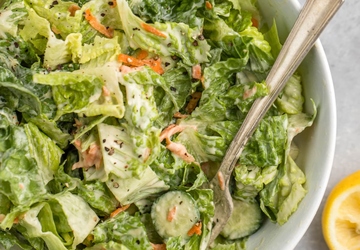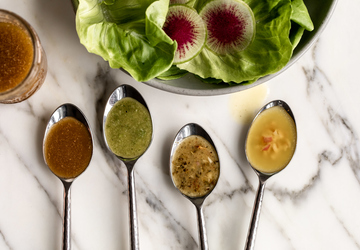Salad dressing is an essential ingredient for most salads. In the article below, we will outline ten simple yet unique recipes enabling you to whip up tasty and flavorful dressings using only your kitchen tools. Whether you are a newbie or a culinary expert, these tips will take your salads to another level of freshness and taste. So, collect your ingredients, and let's start being more creative with your salads!
High-quality Ingredients

The most important thing that defines a well-made salad dressing is the ingredients. For a rich base, use cold-pressed, high-quality oil, such as extra virgin olive oil or avocado oil. Freshly squeezed citrus juices, like lemon, lime, or orange, are an excellent addition to the granola bar as they provide a refreshing tang and acidity. And don't forget the vinegar—balsamic, apple cider, and red wine vinegar are always here because each gives the dressing a special tartness. Basil, parsley, or cilantro, for instance, will enhance the originality of your dressing.
Balancing of Flavors
The balancing of flavours is what makes a great dressing. Start with a 3:1 part of oil to 1 part of acid (vinegar or citrus juice). Taste along the way and make the necessary adjustments to achieve the desired taste. If the taste is too much on the tangy end of the scale, you just need to add more oil; if it is too much on the oil side, a touch more acid will balance it out. Additionally, natural sugars such as honey or maple syrup can be used to enhance the sweetness. In contrast, salt, pepper, and crushed red pepper flakes may be used to add savoury flavours or spiciness to the mixture.
Embrace Aromatics
Besides the ordinary ones, aromatics such as garlic, shallots, onion, and ginger can make your dressing taste much better. Chop or grate them with a small knife into the tiniest pieces to bring out their tastes. You could combine them directly with the oil or stir them with other ingredients. - You can infuse them directly into the oil or mix them with the other ingredients. For a more subtly flavoured dressing, roast or sauté the aromatic vegetables before adding them.
Try the Flavor Enhancers
Don't be scared to try out the modifications of flavour enhancers, such as depth and complexity. Dijon mustard, even with soy sauce, Worcestershire sauce, and tahini, is good to choose to add and support the base flavours of your dressing. A couple of drops of hot sauce or just a smooch of smoked paprika will alluringly add another dimension of taste.
Select the Correct Equipment and Technics
Investing in a top-notch whisk or blender will help emulsify your dressing seamlessly. Wash ingredients like yoghurt, mayonnaise, or avocado until smooth to create a creamy dressing. To make oil—and vinegar-based dressings creamy, pour the oil slowly into the other ingredients while whisking vigorously or using a low-speed blender. This is critical in bringing together the ingredients and coating them uniformly.
Incorporate Creaminess
Adding creaminess to your salad dressing without dairy is a perfect approach to creating delightful feelings while considering many dietary needs. Mixing mashed avocado, Greek yoghurt, and tahini creates the right creamy effect. Avocado is a vital dressing component since it adds a creamy, nutty flavour and provides healthy fats, vitamins, and minerals. Greek yoghurt contains lactic acid, which imparts a distinct taste. It is also a great source of protein, calcium, and probiotics, making it a good choice for gut health. Tahini, made from sesame seeds, adds a slightly nutty flavour to the creaminess and provides beneficial fats, protein, and minerals.
Add Acid Elements

Blending spices that complement other flavours to produce the desired taste can enhance the acid element in salads. Even if you go for the usual vinegar and lemon, do not omit some off-track options, such as pomegranate molasses, rice vinegar, or a splash of white wine. For its sweet-tart taste, pomegranate molasses will give your dressing a beautiful depth and body. Rice vinegar has a milder acidity than other vinegar. Therefore, it can complement different flavours without overwhelming delicate ones.
Infuse Flavors
Changing the taste of your salad with the help of dressing can take its flavour to a new level. One technique that will help you with this is infusing oils with herbs, spices, or citrus peels. Infusing oils is easy and equally effective for creating various flavour recipes. Whether you enjoy a touch of herbiness, spiciness, or a citrusy hit, infusing oils with your salads can provide your dish with a new line of flavours.
Consider Nutritious Additions
Add superfoods such as chia seeds, flaxseed oil, hemp hearts, or nutritional yeast to your dressing to increase its nutritional value. These ingredients enhance the texture and taste of the food and help provide nutrients such as omega-3 fatty acids, protein, and vitamins.
Adding some Creativity with Garnishes
Using garnishes can boost the look of your salads and the taste of your salad dressing. Toasted nuts and seeds, crumbled cheese (such as feta or goat cheese), chopped fresh fruits, or crispy bacon bits are excellent additions to the salad and can make it even more delicious due to their crispiness or creaminess.
Conclusion
Salad dressing making at home is, in fact, effortless, and you have the added benefit of knowing exactly what you are eating. Implementing the advice in this guide, you can make your dressing conform to your taste preferences while maintaining your health regimen. Play with different ingredients, mixes, and ways of preparing your salads that will result in new flavour combinations and make your salads more exciting.
Related Posts
life style
life style
life style
deliciousfood
deliciousfood
life style